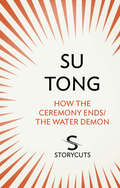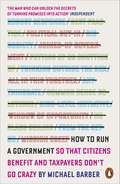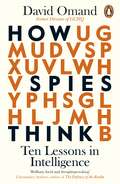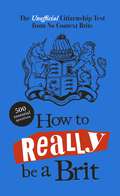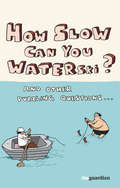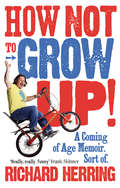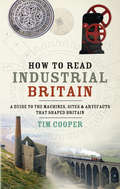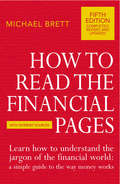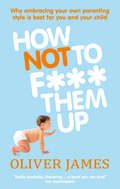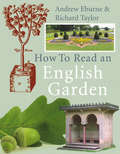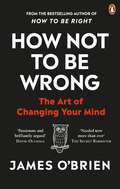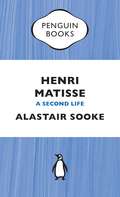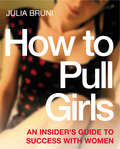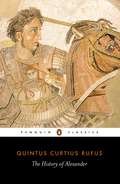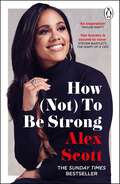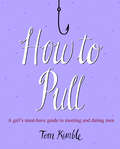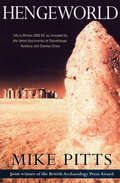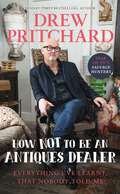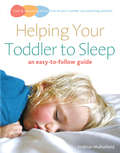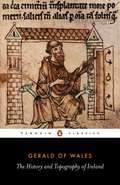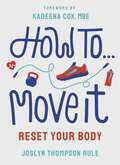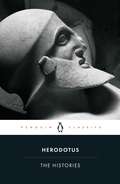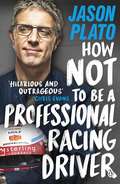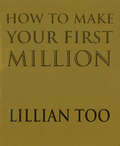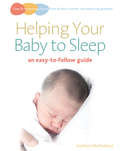- Table View
- List View
How the Ceremony Ends/The Water Demon (Storycuts)
by Su TongIn 'How the Ceremony Ends', it was last winter that the folklorist paid his visit to the village of Eight Pines. He wanted to collect folk tales and customs, to re-enact the ceremonies of life and death that only old men still remember. But somehow he managed to provoke the villagers.In 'The Water Demon', at the beginning, no-one noticed the little girl on the bridge. No-one knew what she was doing; she just stood and watched. She would call out loudly, 'Here comes the water demon! Get out of the water or he will get you by the feet!' and tear away out of sight. Then, one day, there was no little girl on the bridge.Part of the Storycuts series, these two short stories were previously published in the collection Madwoman on the Bridge.
How to Run A Government: So that Citizens Benefit and Taxpayers Don't Go Crazy
by Michael BarberBillions of citizens around the world are frustrated with their governments. Why is this? And what can we do about it? In this groundbreaking book Michael Barber draws on his wealth of international experience advising political leaders, to show how those in power can make good on their promises. 'Refreshingly ruthless ... has an uplifting brio to it' Economist'Michael Barber is a source of inspiration and wisdom' Andrew Adonis, New Statesman'Excellent ... there is a lot of common sense and practical wisdom ... a breath of fresh air' David Willetts,Standpoint'Barber is the global overlord of public policy ... a record around the world of actually achieving change' Philip Collins, Prospect
How Spies Think: Ten Lessons in Intelligence
by David OmandFrom the former director of GCHQ, learn the methodology used by British intelligence agencies to reach judgements, establish the right level of confidence and act decisively.Full of revealing examples from a storied career, including key briefings with Prime Ministers and strategies used in conflicts from the Cold War to the present, in How Spies Think Professor Sir David Omand arms us with the tools to sort fact from fiction.And shows us how to use real intelligence every day.*****'One of the best books ever written about intelligence analysis and its long-term lessons' Christopher Andrew, The Defence of the Realm: The Authorized History of MI5'An invaluable guide to avoiding self-deception and fake news' Melanie Phillips, The TimesWINNER OF THE NEAVE BOOK PRIZE 2022LONGLISTED FOR THE ORWELL PRIZE FOR POLITICAL WRITING 2021
How to Really be a Brit: The Unofficial Citizenship Test
by No Context BritsThis is the perfect gift for the least traditional person in your life - or an affectionate nod to the most!'Whilst the biggest political figures and finest historians have struggled for over a century to truly define what "being British" is, No Context Brits manages to do it five times a week, easily, on Twitter' CAITLIN MORAN Do you know what year the Harrier jump jet was developed?What about the name of the first king of Scotland? Surely you must know the contents of the 1969 Bill of Rights?! Don't know the answers? Sorry, according to the Home Office, you're clearly not cut out to be a British Citizen. These inane questions have been posed by the Life in the UK test, more commonly known as the British citizenship test. If only there was an alternative test that wasn't stuck revelling in past glories . . . one that was fun, irreverent and unafraid to offer a glimpse of real life in the UK.How to Really be Brit is the unofficial citizenship test from the beloved No Context Brits Twitter account. You'll find 500 questions taking in every aspect of UK life - from Wrexham to Windrush, Bake Off to Brexit, scotch eggs to the Spice Girls and more.
How Slow Can you Waterski?: and other puzzling questions ...
by Guardian News and Media LtdWhen the powers that be reduced the speed limit on Lake Windermere to 10 knots, waterskiers complained that their sport was now completely scuppered. So just how slow can you waterski before you start to sink beneath the waves?And, while we're about it, how long can you survive in a freezer? What are the chances of being struck by lightning in bed? And why is it so esay to raed wrods eevn wehn the lteetrs are mdduled up?Everyday life can pose some mind-boggling questions - but where do you find the answers? The Guardian's popular 'This Week' column has been looking into the science behind the news for three years, and How Slow Can You Waterski? draws together a selection of the most imaginative questions and the most surprising answers. If you've ever wondered what makes a planet a planet, why submarines keep bumping into things or even if it's safe to eat mud, How Slow Can You Waterski? will prove irresistible - and enlightening - reading.
How Not to Grow Up: A Coming of Age Memoir. Sort of.
by Richard HerringComedian Richard Herring has a major problem. He's about to turn 40 and hasn't seen it coming. He's not married, doesn't have a proper job or 2.4 children. But now, finally, it looks as if the world expects him to be a grown up - and he's completely unprepared for it.As the momentous and terrifying event approaches (his birthday), Richard notices a steep decline in his own behaviour. Inexplicably he begins to behave more childishly - hanging out with 22-year-olds, developing an unhealthy addiction to Flumps and even getting into a ludicrous fight.How Not to Grow Up is the funny story of how a self-confessed perpetual Big Kid deals with his greatest fear - getting older - and is the perfect book for everyone who, deep down, still thinks that they're 18.
How to Read Industrial Britain
by Tim CooperFrom steam engines and suspension bridges to canals, factories and pubs, the Industrial Revolution of the 18th and 19th centuries transformed the social and material landscape of Britain. Yet how many of us know why our local pub looks the way it does or why a railway station might resemble a cathedral? This book reveals how, by 'reading' buildings, structures and townscapes, we can understand their context and significance for the society that created them.Author Tim Cooper uses themes including transport, education and religion to show how the geographical and architectural remains of industrial Britain have shaped us as a people. He sheds light on how and why the pioneers of the Industrial Revolution redesigned our towns and countryside, and draws on a wealth of British sites to explain, for instance, how canals were instrumental in the expansion of industry, or why affluent suburbs are usually situated in the west end of a town.This book is a joy for anyone wanting to investigate our industrial heritage and discover the secret history behind familiar, everyday features of our urban and rural landscapes.
How To Read The Financial Pages
by Michael BrettStripping away the mystique from the world of investment and finance, How to Read the Financial Pages is a layman's guide to reading and understanding the financial press and the markets and events it covers. Assuming no financial knowledge, Michael Brett provides a valuable explanation of the workings of the financial world - from money markets to commodity markets, investment ratios to takeover bids. With an extensive glossary of financial terms, this book will help you through the financial columns to a better understanding of the language of markets and money. For ten years How to Read the Financial Pages has been an outstanding first-choice buy for everyone who wants a thorough - but friendly - grounding in finance and investment.--What are stock markets, currency markets, commodities markets? How do they operate?--What are derivatives? Could they cause the financial system to crash?--What is meant by insider dealing? Why is it illegal?--Who are the main players in the world of money? What do stock brokers, market makers, merchant bankers and underwriters actually do?--How has the Internet affected private investors? What are the new opportunities?
How Not to F*** Them Up
by Oliver JamesAs a mother, are you comfortable in your skin?Want to know how best to be a stay-at-home or working mum?Babies have very simple needs, yet many parents are overwhelmed with elaborate advice on how to meet them. In How Not to F*** Them Up, leading child psychologist Oliver James argues that your under-threes do not need training; it's getting your head straight as a parent that's important.Drawing on extensive interviews and the lastest clinical research, James identifies three basic types of mum: the Hugger, the Organiser and the Fleximum. Outlining the benefits and pitfalls of each, How Not to F*** Them Up shows you how to recognise which style suits you best and outlines simple strategies to reconcile personal ambitions with the needs of your family.Empowering and provocative, Oliver James will help you make the best choices for bringing up a happy, confident child.
How to Read an English Garden
by Andrew Eburne Dr Richard TaylorRichard Taylor, author of the best-selling How to Read a Church, joins forces with garden historian Andrew Eburne to produce the ultimate guide to historic and modern gardens. Gardens are amongst the fastest-growing visitor attractions today - in the UK alone 15 million people will visit a garden this year. How to Read an English Garden is the essential book for every garden lover. It provides an account of the different elements of gardens of all ages and explains their meaning and their history: here, you'll find the answer to such questions as: when were tulips introduced into our gardens, and what was 'tulip-mania'? What is a knot-garden, and what was the origin of its design? Who was 'Capability' Brown, and how did he get his name? Why are mazes such a common feature in English garden design? In addition, the book explains how lawns, flowerbeds, trees and ponds came to be a feature not just of grand houses but of gardens everywhere. Among the many subjects covered are: garden design, plant introductions and collectors, kitchen gardens, water gardens, and garden styles from around the world: English, American, Chinese and Moorish to name just a few. Clearly laid out and beautifully illustrated, How to Read an English Garden brings historic and modern gardens to life: a book to accompany garden visitors everywhere, or to be enjoyed and dipped into at home.
How Not To Be Wrong: The Art of Changing Your Mind
by James O'Brien'Simply Brilliant' THE SECRET BARRISTER'Passionate and brilliantly argued' DAVID OLUSOGA'An admirably personal guide' MARINA HYDE'Smart, analytical, self-aware and important' ALASTAIR CAMPBELLTHE INTIMATE, REVEALING NEW BOOK FROM THE AUTHOR OF THE BESTSELLING, PRIZE-WINNING HOW TO BE RIGHT There's no point having a mind if you're not willing to change it James O'Brien has built well over a million loyal listeners to his radio show by dissecting the opinions of callers live on air, every day. But winning the argument doesn't necessarily mean you're right. In this deeply personal book, James turns the mirror on himself to reveal what he has changed his mind about and why, and explores how examining and changing our own views is our new civic duty in a world of outrage, disagreement and echo chambers. He writes candidly about the stiff upper lip attitudes and toxic masculinity that coloured his childhood, and the therapy and personal growth that have led him question his assumptions and explore new perspectives. Laying open his personal views on everything from racial prejudice to emotional vulnerability, from fat-shaming to tattoos, he then delves into the real reasons -- often irrational or unconscious -- he holds them. Unflinchingly honest, revealing and funny, How Not to Be Wrong is a tonic for a world more divided than ever and a personal manifesto for a better way of thinking and living. Because after all, if we can't change our own minds we'll never really be able to change anyone else's.
Henri Matisse: A Second Life
by Alastair SookeHenri Matisse by Alastair Sooke - an essential guide to one of the 20th century's greatest artists'One January morning in 1941, only a fortnight or so after his seventy-first birthday, the bearded and bespectacled French artist Henri Matisse was lying in a hospital bed preparing to die.'Diagnosed with cancer, the acclaimed painter, and rival of Picasso, seemed to be facing his demise. Then something unexpected happened. After a life-saving operation that left him too weak to paint, and often too frail to even get out of bed, Matisse invented a ground-breaking and effortless new way of making art. The results rank among his greatest work.In an astonishing blaze of creativity, he began conjuring mesmerising designs of dazzling dancers and thrilling tightrope walkers, sensuous swimmers and mythical figures falling from the heavens. His joyful and unprecedented new works were as spontaneous as jazz music and as wondrous as crystal-clear lagoons. Their medium? Coloured paper and scissors.This book, by art critic and broadcaster Alastair Sooke, focuses on Matisse's extraordinary final decade, which he called 'a second life', after he had returned from the grave. Both a biography and a guide to Matisse's 'cut-outs', it tells the story of the valedictory flourish of one of the most important and beloved artists of the twentieth century.Published in time for a major Tate Modern retrospective.'Sooke is an immensely engaging character. He has none of the weighty self-regard that often afflicts art experts and critics; rather he approaches his subjects with a questioning, open, exploratory attitude' Sarah Vine, The Times 'His shows are excellent - clever, lively, scholarly, but not too lecturey; he's very good at linking his painters with the world outside the studio, and at how these artists have affected the world today' Sam Wollaston reviewing 'Modern Masters', GuardianAlastair Sooke is art critic of the Daily Telegraph. He has written and presented documentaries on television and radio for the BBC, including Modern Masters, The World's Most ExpensivePaintings, Treasures of Ancient Rome and, most recently, Treasures of Ancient Egypt. He is a regular reporter for The Culture Show on BBC Two. He is the author of Roy Lichtenstein: How Modern Art was Saved by Donald Duck.
How To Pull Girls: An Insider Guide To Success With Women
by Julia BruniFor many men, changes in society have made it harder to get to know women and pulling has become more difficult than it's ever been. The result is that many capable and otherwise successful young men feel frustrated by not having a girlfriend - or even a lay. How to Pull Girls gives the lowdown on how to meet and charm girls. Whether you need to relax and set women at ease, or to understand how girls think and what motivates them, Julia Bruni has all the insider information, analysing the pulling game from every angle. How to Pull Girls is packed full with useful strategies and techniques for every stage of the women-charming mission and will transform you from a Mr Normal to a James Bond in a matter of minutes. This is the essential pulling tool kit 'Women, be warned. Julia's on their side and she is telling them our secrets!'' Kathy Lette
The History of Alexander
by Quintus Curtius RufusAlexander the Great (356-323 BC), who led the Macedonian army to victory in Egypt, Syria, Persia and India, was perhaps the most successful conqueror the world has ever seen. Yet although no other individual has attracted so much speculation across the centuries, Alexander himself remains an enigma. Curtius' History offers a great deal of information unobtainable from other sources of the time. A compelling narrative of a turbulent era, the work recounts events on a heroic scale, detailing court intrigue, stirring speeches and brutal battles - among them, those of Macedonia's great war with Persia, which was to culminate in Alexander's final triumph over King Darius and the defeat of an ancient and mighty empire. It also provides by far the most plausible and haunting portrait of Alexander we possess: a brilliantly realized image of a man ruined by constant good fortune in his youth.
How (Not) To Be Strong: The inspirational instant Sunday Times Bestseller from the legendary Lioness
by Alex ScottAn inspiring memoir of finding strength and resilience from the former England Lioness.From the football cages of East London to broadcasting to millions, the engine powering Alex Scott's remarkable journey has always been her resilience. But thanks to a 'push-through mentality' the world has only ever seen the 'strong' side of Alex. Now, she is ready to lower the shield.In her candid memoir How (Not) to Be Strong, Alex shares the lessons that have shaped her, from finally confronting the legacy of a tumultuous childhood to tarnished truth behind the gleaming football trophies.With raw honesty, Alex shows how she's tackled life's challenges and that sometimes the strongest thing you can do is show your most vulnerable side to the world.
How to Pull: A girl's must-have guide to meeting and dating men
by Tom KimbleMost single girls will tell you that meeting and dating men is a minefield. Yet so many relationship books tell girls the things they don't want to hear (why all men are scoundrels) as opposed to what they really want to know - how to navigate that minefield to meet, date and ultimately bag, the man of their dreams.How to Pull fills that gap in the relationship book market. It's packed with all the essentials from how to hook him with that first look, to dating scenarios, moving in for the kill, playing the texting or email game and what to wear on a first date. What's more, it's written by a man and by allowing girls to understand how an insider thinks, it answers all the questions they agonise over: how long should you wait to return his text, does it pay to seem busy or desired by other men and what does he want his friends to think when they meet you. How to Pull is a fun, indispensable guide to finding (and keeping) a man that all single girls will be desperate to get their hands on.
Hengeworld
by Michael PittsIn November 1997 English Heritage announced the discovery of a vast prehistoric temple in Somerset. The extraordinary wooden rings at Stanton Drew are the most recent and biggest of a series of remarkable discoveries that have transformed the way archaeologists think of the great monuments in the region, including Avebury and Stonehenge; one of the world's most famous prehistoric monuments, top tourist site and top location for summer solstice celebrations. The results of these discoveries have not been published outside academic journals and no one has considered the wider implications of these finds. Here Mike Pitts, who has worked as an archaeologist at Avebury, and has access to the unpublished English Heritage files, asks what sort of people designed and built these extraordinary neolithic structures - the biggest in Britain until the arrival of medieval cathedrals. Using computer reconstructions he shows what they looked like and asks what they are for. This is the story of the discovery of a lost civilisation that spanned five centuries, a civilisation that now lies mostly beneath the fields of Southern England.
How Not to Be an Antiques Dealer: Everything I've learnt, that nobody told me
by Drew Pritchard'Over the years I've had some incredible finds, but the one that excites me the most is the next one.' Drew Pritchard set himself up as a dealer when he was a teenager, rooting around in scrapyards, working out of a shed and getting about in a ropy old Transit. Now he's a leading figure in the antiques trade with an international online business, and he's hugely popular presenter of hit TV show Salvage Hunters. But he's still as driven by the thrill of the find as he was forty years ago.In this engaging and informative narrative, clearly structured into practical themes, Drew reveals what it takes to start with nothing but an obsession and a dream. He shows you how to create the opportunities, establish a network, get the best out of auctions and fairs, spot the fakes, develop your eye, build a reputation, buy and sell and yes, make a profit.Whether you are a professional dealer or an amateur enthusiast, and whatever your budget, Drew's on a mission to show you how to enrich your life with beautiful things, that have their own unique story and that bring you joy. And then how to part with them for cash!
Helping Your Toddler to Sleep: an easy-to-follow guide
by Siobhan MulhollandA new title in the series of beautifully illustrated and easy-to-follow practical guides covering all the essential phases of childcare.Getting your toddler to sleep, and to sleep well, can become a battle that can be tiring and upsetting for both parent and child. And the less sleep they get, the more tiring it can be. This comprehensive guide - the first to be aimed purely at toddlers - offers practical guidance and clear guidelines on how to achieve the best result. From sleep cycles and nap times to food and mental attitude, Helping Your Toddler to Sleep is the only book parents need to ensure that their toddler - and they - get as much sleep as they need.
The History and Topography of Ireland
by Gerald of WalesGerald of Wales was among the most dynamic and fascinating churchmen of the twelfth century. A member of one of the leading Norman families involved in the invasion of Ireland, he first visited there in 1183 and later returned in the entourage of Henry II. The resulting Topographia Hiberniae is an extraordinary account of his travels. Here he describes landscapes, fish, birds and animals; recounts the history of Ireland's rulers; and tells fantastical stories of magic wells and deadly whirlpools, strange creatures and evil spirits. Written from the point of view of an invader and reformer, this work has been rightly criticized for its portrait of a primitive land, yet it is also one of the most important sources for what is known of Ireland during the Middle Ages.
How To Move It: Reset Your Body (Merky How To #5)
by Joslyn Thompson RuleIntroducing the new 'How To...' series from #Merky Books: unlock your potential with our short, practical pocket-sized guides._______________________________________________________How to Move It: Reset Your BodyThis book is about motivating your body through the power of movement, focusing on you as an individual and not the ideal of fitness we see so often. Before you lift a single kettle bell or hit the yoga mat, Nike Master Trainer Joslyn Thompson Rule will break down the stages to moving your body for the better. Starting with your brain, then your breathing and finally your body. Packed full with motivational and practical exercises for mobility, strength, conditioning, and recovery. This book is a personal trainer in your pocket, encouraging you along the way and helping you to have a healthy relationship with fitness.Written by Joslyn Thompson RuleForeword by Kadeena Cox, MBE_______________________________________________________Designed to inspire and encourage readers to unlock their potential and provoke change, the How To series offers a new model in publishing, helping to break down knowledge barriers and uplift the next generation.Creatively presented and packed with clear, step-by-step, practical advice, this series is essential reading for anyone seeking guidance to thrive in the modern world. Curate your bookshelf with these collectible titles.
The Histories
by Herodotus'The first example of non-fiction, the text that underlies the entire discipline of history ... it is above all a treasure trove' Tom HollandOne of the masterpieces of classical literature, The Histories describes how a small and quarrelsome band of Greek city states united to repel the might of the Persian empire. But while this epic struggle forms the core of his work, Herodotus' natural curiosity frequently gives rise to colourful digressions - a description of the natural wonders of Egypt; tales of lake-dwellers, dog-headed men and gold-digging ants. With its kaleidoscopic blend of fact and legend, The Histories offers a compelling Greek view of the world in the fifth century BC, in Aubrey de Sélincourt's elegant and celebrated translation.Translated by AUBREY DE SÉLINCOURT Revised with an Introduction and notes by JOHN MARINCOLA
How Not to Be a Professional Racing Driver
by Jason Plato'HILARIOUS AND OUTRAGEOUS' CHRIS EVANS THE HILARIOUS FULL-THROTTLE MEMOIR FROM ONE OF THE BIGGEST CHARACTERS IN UK MOTOR RACINGSHORTLISTED FOR THE TELEGRAPH SPORTS BOOK AWARDS 2020 Two-time championship-winning and record-breaking racing driver, Jason Plato is a living, breathing example of what you shouldn't do if you want to become a professional racing driver: DO NOT: · Steal a JCB in Monaco and end up in prison there - twice · Kill Bernie Ecclestone (almost) · Choose fags and booze over the gym · Give Prince Charles the finger on the M42 · Make enemies with a 6ft 6" rival who is a black belt in everything Since joining the Williams Touring Car team in 1997 he has had more race wins than Lewis Hamilton and Stirling Moss, competed in more races than Jenson Button and set the largest number of fastest laps ever. But he's also a rule breaker who has had more than his fair share of near-death experiences, drunken escapades and more. There is nothing sensible, predictable or considered about Jason.But this is how he became a racing legend. ______ LONGLISTED FOR THE TELEGRAPH SPORTS BOOK OF THE YEAR AUTOBIOGRAPHY AWARD 'As entertaining as watching him drive, a cracking read!' Sir Chris Hoy 'Jason Plato is one of the most gifted racing drivers of his generation!' Damon Hill
How To Make Your First Million
by Lillian TooIn HOW TO MAKE YOUR FIRST MILLION, Lillian Too combines her canny understanding of the business world, her knowledge of personal financial management and her expertise with feng shui to show you how to become rich beyond your wildest dreams. In simple, accessible terms, she explains the importance of planning, focussed thinking, a positive attitude and harnessing the powers of luck in order to pave your way to prosperity.
Helping Your Baby to Sleep: An easy-to-follow guide
by Siobhan MulhollandFrom the leading publishers of parenting books comes a brand new series of beautifully illustrated and easy-to-follow guides covering all the essential phases of childcare. Getting your baby to sleep well and sleep often enough can be one of the hardest aspects of parenting and there is wide-ranging advice on the best ways to do so. This comprehensive guide offers parents practical and reassuring advice on every aspect of helping a baby to sleep using simple, clear guidelines. From sleep cycles and nap times to sleep safety and nightmares, Helping Your Baby to Sleep is the only book parents need to ensure that their baby - and themselves - slumber peacefully.
